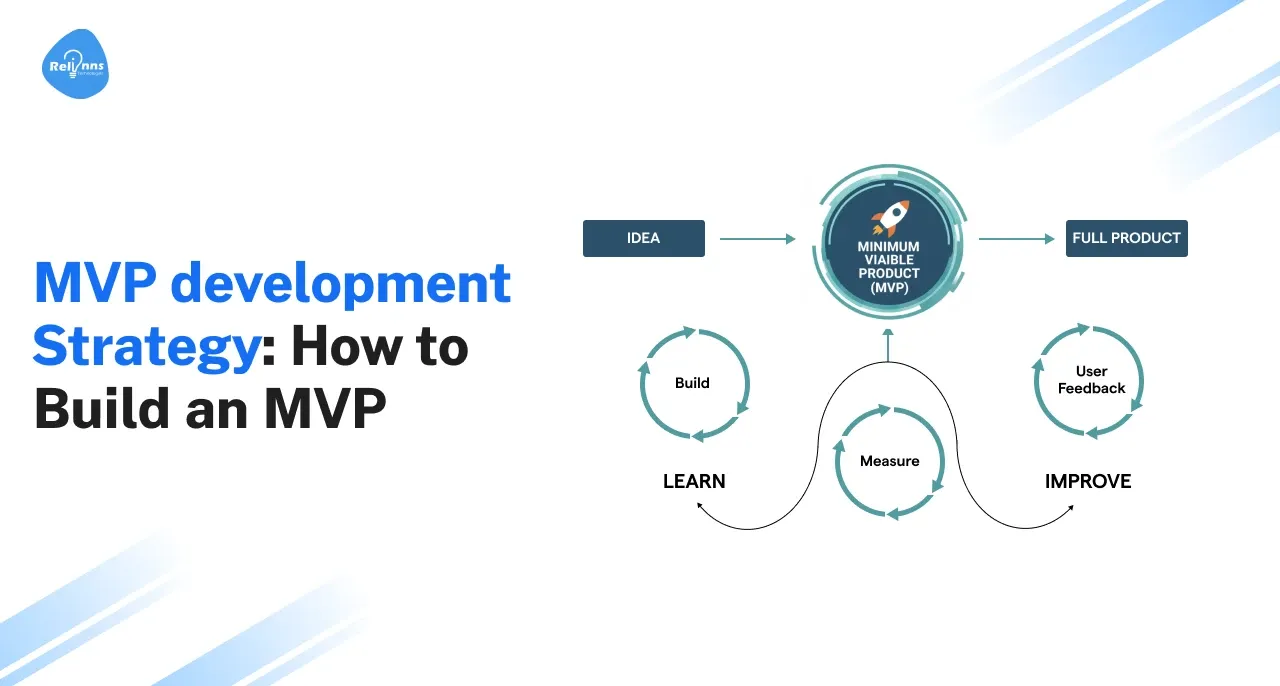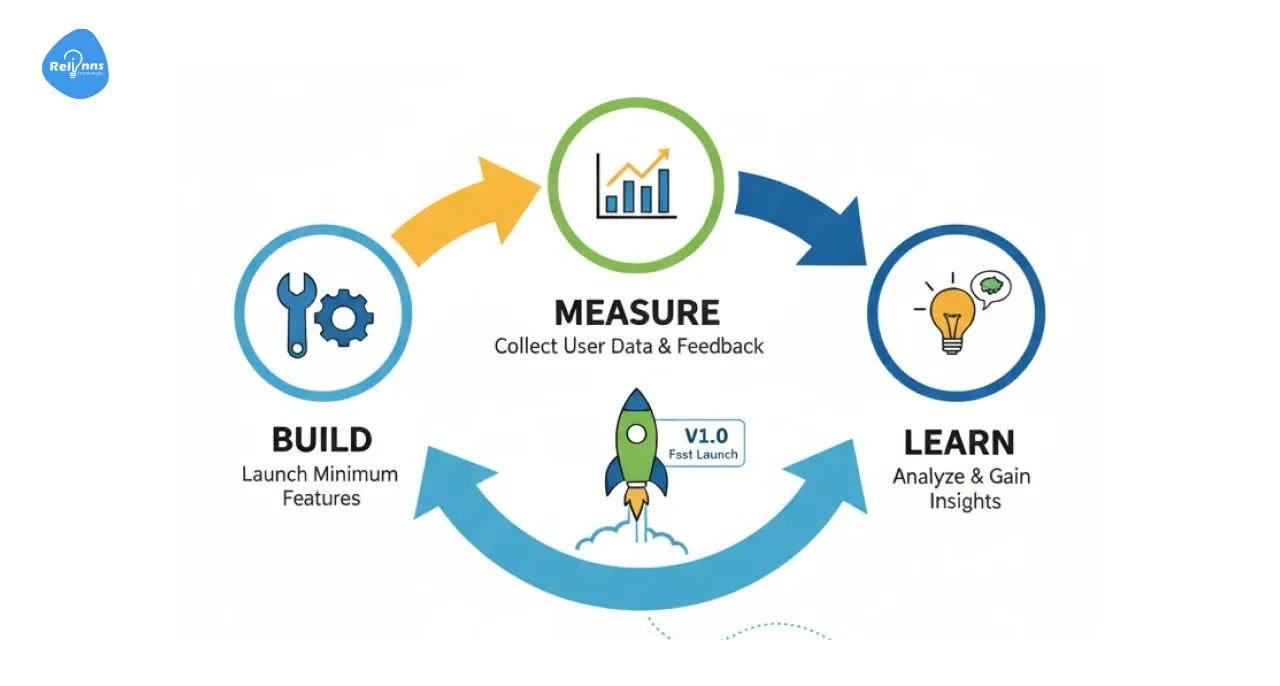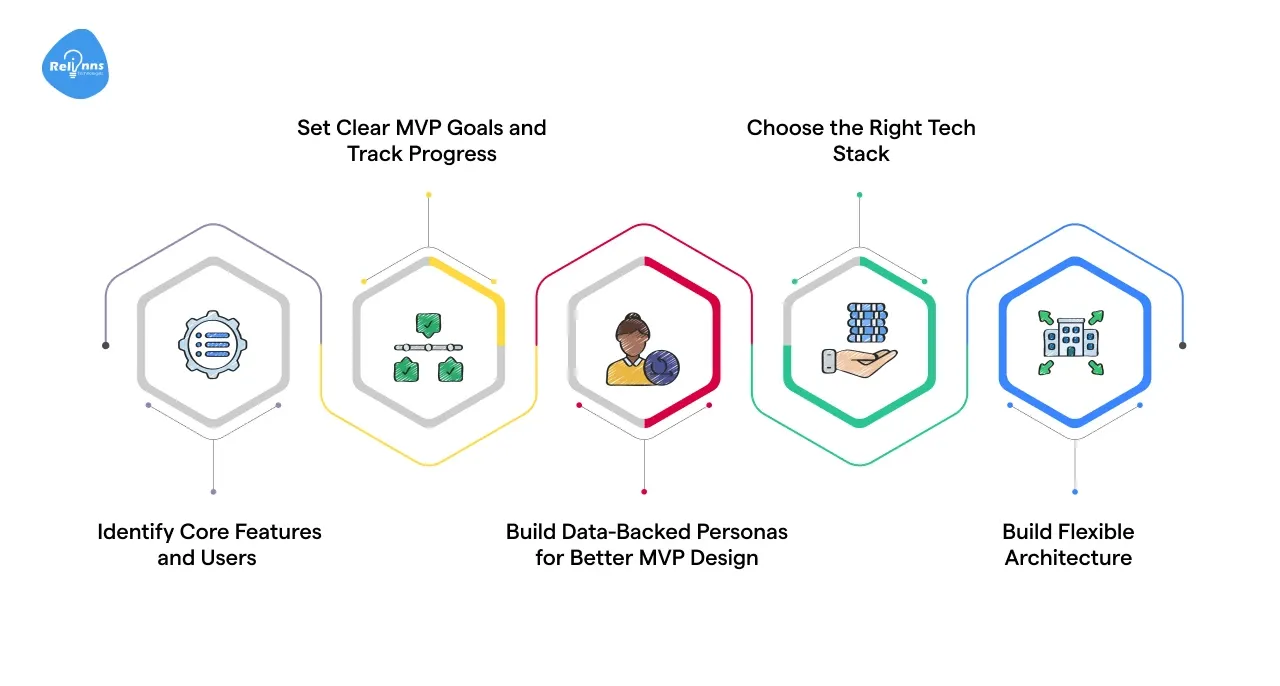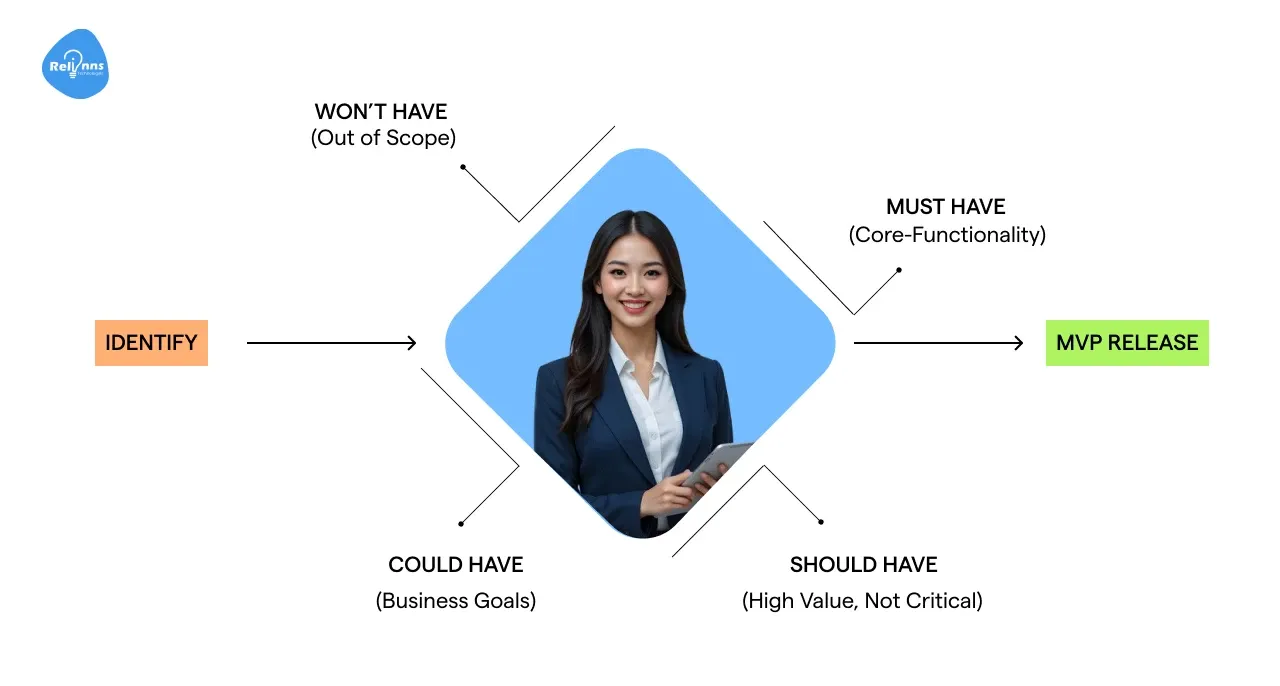MVP development Strategy: How to Build an MVP in 2026
Date
Nov 12, 25
Reading Time
8 Minutes
Category
Custom development

Launching a new product often starts with a clear strategy to minimize risk and cost. A Minimum Viable Product (MVP) is the simplest version of your idea that solves one core problem.
This approach lets you test assumptions quickly and gather honest user feedback.
In 2025, entrepreneurs will have many app development technologies at their disposal, from Java and Swift to cross-platform tools like Flutter and AI-driven frameworks. These modern tools enable rapid prototyping and faster time-to-market.
Approximately 80% of startups report using MVPs to validate ideas and refine their product based on feedback.
This blog will show you how to plan an effective MVP strategy, pick the right development platform, and iterate using real data. By combining lean startup principles with the best mobile app development technologies, non-technical founders can bring ideas to life more efficiently.
What is a Good MVP Strategy?

A good MVP strategy follows lean principles: build fast, measure results, and learn continuously. The MVP should focus on your core value proposition and solve one main problem for a specific user group.
For example, in the build-measure-learn loop, you launch a basic version of your product to collect metrics and feedback, then use that data to inform your next steps.
Key elements include defining one clear hypothesis to test and resisting feature bloat.
Focus on the essential features that deliver value now, and postpone or eliminate everything else. For startups, this means prioritizing tasks that directly address the customer’s pain point and avoiding “nice-to-have” features that delay launch.
This lean approach ensures you don’t waste time or resources building functionality that users don’t actually need.
Here Are the Custom MVP Software Development Strategies

Bringing an idea to life demands more than just a working prototype; it calls for a solid plan.
Here’s where custom MVP software development strategies help reduce time-to-market and optimize resource allocation.
Whether you're using modern app development technologies or choosing from the top 10 mobile app development tools, these strategies lay the groundwork for success.
1. Identify Core Features and Users
Before building anything, define the essential features and who they serve. Conduct interviews to discover which app development technologies your users actually expect.
This clarity ensures your MVP software development plan doesn’t waste time on unnecessary functionality.
- Conduct interviews to identify app development technologies users actually need.
- Shortlist essential features that align with MVP software development goals.
- Eliminate all extras that don’t solve core user problems.
2. Set Clear MVP Goals and Track Progress
Set specific, measurable objectives and KPIs for your MVP. Break your project into milestones or sprints.
Track progress against timelines and success metrics. Clear goals guide the team and help you measure whether the MVP is on track or if you need to pivot.
- Align MVP with app development technologies and business growth targets.
- Use sprints and tools from the mobile app development technologies list.
- Track metrics using the top 10 mobile app development tools.
3. Build Data-Backed Personas for Better MVP Design
Create detailed user personas for each target customer segment. Use these personas to guide your design choices and feature prioritization.
Gathering early feedback from real users helps validate assumptions and fine-tune your MVP scope. This process ensures your MVP addresses a real problem for a real audience.
- Validate user needs using examples of mobile app development technologies.
- Refine features from the application development technologies list and feedback.
- Ensure personas align with expectations for iOS app development technologies.
4. Choose the Right Tech Stack
Pick app development technologies and platforms that align with your project’s complexity, timeline, and your team’s skill set.
Opt for frameworks that support agile mobile app development and enable future scalability. If growth is expected, prioritize application development technologies known for performance and seamless scaling.
- Use mobile app development technologies that support rapid MVP delivery.
- Choose scalable tools from the application development technologies list.
- Match stack with team skills for faster mobile app development.
5. Build Flexible Architecture
Design your MVP on a modular, scalable foundation from the beginning. Use cloud services or a microservices-based architecture to enable seamless updates, feature additions, and scaling.
A flexible backend ensures your app evolves smoothly over time as user needs change without having to rebuild from scratch.
- Use mobile app development technologies that support modular backend design.
- Choose scalable components from the app development technologies list.
- Microservices allow faster updates using the top 10 mobile app tools.
What Problem Are You Solving, and Who Are Your Users?
Start by clearly defining the problem your MVP will address. Conduct market research and user interviews to understand real user needs.
Define your target audience and their pain points. For instance, identify one primary user persona and one core problem they face. By focusing on a single problem-user pair, you make your MVP design much clearer.
Use the insights to shape your MVP. If you know exactly what drives your users, you can tailor the features to meet those needs. Creating user personas and use cases helps keep the team aligned on who the users are and what they want.
For example, if your target user is a busy mom who needs quick grocery delivery, you would focus the MVP on a smooth ordering interface and a fast checkout.
Gathering user feedback early will confirm that the problem you chose is the right one to solve.
How Do You Identify and Prioritize Essential MVP Features?

Begin by listing all features you could include.
Then prioritize ruthlessly. Select only the features that directly solve your users’ primary problems. One method is to score each feature by its impact on the issue and on development effort. Only put the highest-impact, lowest-effort features into the MVP.
The Studiolabs guide suggests focusing on “minimum viable features” to provide a meaningful experience.
In practice, this often means using techniques like user story mapping or simple voting within your team.
For example, list features on sticky notes and have everyone rank them. Keep the Top 3–5 that are essential. By clearly defining the MVP scope upfront, you avoid feature creep and stay on schedule.
Which Low-Code or No-Code Platform Suits Your MVP Goals?
Low-code and no-code platforms let you build apps without heavy coding.
Selecting the right tool is crucial to building your MVP efficiently.
Depending on your team's expertise and project goals, you may choose between low-code platforms like Joget or Mendix, or no-code tools like Glide or Bubble.
Each supports fast iteration and scalable builds using visual development environments.
Choosing the Right Low-Code/No-Code Platform
- Joget DX is ideal for building scalable business apps without deep coding.
- Mendix suits complex workflows needing enterprise-grade app development technologies.
- Bubble and Glide enable non-developers to launch apps using drag-and-drop editors.
- 70% of apps are expected to use low-code/no-code by 2025 (Gartner).
- Use tools aligned with your mobile app development technologies roadmap.
Key Considerations Before Platform Selection

- Consider team skill level and app complexity before selecting a platform.
- Explore the list of application development technologies on GitHub for comparison.
- Relinns specializes in Joget and Mendix for successful MVP software development.
How Do You Design, Prototype, and Launch Your MVP Quickly?
For building the MVP, adopt an agile approach. Break work into short sprints, each focused on delivering a functional piece of the app
A. Design: Lay the Right Foundation from Day One
Design is where your MVP's success begins. Prioritize intuitive layouts and mobile app development technologies that ensure a seamless user experience.
Always build with your end user in mind. Clarity, responsiveness, and usability matter more than polish at this stage.
- Prioritize UI/UX that aligns with core mobile app development technologies.
- Map key user journeys and screens to enhance usability.
- Use tools like Figma or Sketch for fast, clean wireframes.
B. Prototype: Validate User Flow Before Writing Any Code
Prototyping helps you spot design flaws early and gather actionable feedback. Instead of jumping into development, test your assumptions using clickable mockups.
This allows real users to interact with your product logic before any code is written, saving time and reducing rework.
- Create clickable prototypes that mirror real mobile app development experiences.
- Conduct quick user tests to confirm layout and functionality work.
- Focus on feedback-driven iteration using examples from app development technologies.
C. Launch: Build and Ship Fast Using Agile Methods
Once your design and prototype are validated, it’s time to develop and deploy. Leverage agile sprints, automation, and scalable frameworks to go live quickly.
Choose application development technologies such as Flutter or React Native to accelerate development and enable cross-platform support.
- Adopt agile methods: use 2-week sprints to ship MVP features.
- Use cross-platform tools like Flutter or React Native for efficiency.
- Automate testing and CI/CD to accelerate app development.
How Will You Validate Your MVP and Gather User Feedback?
Once your MVP is live with early users, measure everything. Track usage metrics (e.g., sign-ups, retention, task completion) and compare them to your goals.
The Lean Startup stresses validated learning: using data to confirm or reject your assumptions. For example, set up analytics to see how users navigate the app. Conduct A/B tests if you’re unsure between two designs.
Also, gather qualitative feedback. Run a small beta test and use in-app surveys or interviews to collect user feedback.
For instance, ask beta users to perform key tasks and note where they struggle. Combining analytics data and user comments tells you if your MVP is solving the intended problem. Use this feedback to identify which features to improve first.
Remember: feedback is your compass.
The product should evolve according to real user needs, not.
What Is Your Plan for Iterating and Scaling Your MVP Based on Data?
Use the data you’ve gathered to decide your next steps. If user metrics and feedback indicate your MVP is on the right track, double down and add the next-highest-priority features.
If not, be ready to pivot: change your approach or target problem based on what you learned.
The Lean Startup calls this the pivot-or-persevere decision loop, always be willing to adjust course to meet user needs better.
As you continue, iterate in rapid cycles.
Each new release should include measurable improvements based on prior feedback. Meanwhile, plan for growth. Implement scaling strategies (such as cloud infrastructure, load balancing, or caching) before you hit performance limits.
For example, if your user base grows, ensure the backend can handle the load. Continuously review your analytics and stay agile: refine features that improve key metrics, and retire or rework those that don’t. This data-driven, iterative approach helps turn your MVP into a scalable product.
Start Building Your Custom MVP Software Development With Relinns
Relinns specializes in custom MVP software development, helping startups and businesses bring their ideas to life efficiently and cost-effectively. By leveraging proven lean startup principles and modern app development technologies, Relinns guides clients through every stage of MVP creation from initial strategy and user research to rapid prototyping, agile development, and data-driven iteration.
Relinns’ expertise in platforms like Joget and Mendix enables fast, scalable MVP builds tailored to your unique business needs.
Their approach focuses on:
- Identifying core features and target users
- Setting clear, measurable MVP goals
- Building data-backed user personas
- Choosing the right tech stack for speed and scalability
- Designing flexible, modular architecture for future growth
With Relinns, you get a partner who understands the importance of validated learning, rapid feedback cycles, and agile development. Whether you’re a non-technical founder or an experienced entrepreneur, Relinns provides the tools, expertise, and support to turn your vision into a successful MVP and, ultimately, a scalable product.
Final Thoughts
Launching a successful MVP starts with a clear focus on solving one core problem for a specific user group, using essential features that deliver real value. By following lean and agile principles, startups can quickly build, test, and refine their product while minimizing wasted time and resources.
Utilizing modern app development technologies and platforms like Joget and Mendix, as supported by Relinns, accelerates the development process and ensures scalability. Continuous user feedback and data-driven iteration enable startups to evolve their MVP into a polished, scalable product that meets market demands and drives business growth.
Why Relinns is Your Ideal MVP development Partner
- 95% delivery accuracy across mobile, web, and low-code platforms.
- 80% faster development using Joget’s drag-and-drop automation tools.
- 4.0/5 client rating for support, strategy, and tech guidance.
- 30+ enterprise projects delivered across healthcare, logistics, and retail.
- 40% reduction in cost vs traditional app development methodologies.
Let Relinns guide your journey from idea to app, with the right blend of technology, expertise, and support.
Contact Relinns Today to build innovative, scalable apps that grow with your business.
Frequently Asked Questions (FAQ's)
What is the MVP approach in software development?
The MVP (Minimum Viable Product) approach focuses on building a basic version of a product with core features to validate ideas, gather user feedback, and reduce development risks.
How to create an MVP plan?
To create an MVP plan, define your target audience, identify key features, design prototypes, develop the core product, test with users, and refine based on feedback and performance.
What is an example of a famous MVP?
A famous MVP example is Dropbox, which started with a simple explainer video demonstrating its concept before developing the full product based on user interest.
Is Flutter a framework or a language?
Flutter is a UI framework developed by Google, while its programming language is Dart. It enables developers to build cross-platform mobile, web, and desktop applications.


